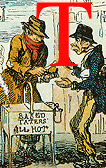[Those curious about the history of the Victorian Web (which began years before the WWW in another hypermedia system) might be interested to learn that this document was one of the very first written specifically for what became this site by someone outside Brown University. (The materials on public health that Professor Wohl also contributed came from his previously published book [GPL].]
 he modern urge to describe humans on a new, explicitly scientific
basis took many, often strange, forms in the nineteenth century.
For example, the science of phrenology, whose heyday was between 1820 and 1850,
and later racial anthropological physiognomy, attracted many followers. That
man's physical and, by extension, moral, intellectual, and social development,
could be determined by, and seen in, his physiognomy — in, say, jaw structure
and shape of the head-- were to many respected sciences that enjoyed wide currency.
(When the archvillain, Moriarity, meets his adversary Sherlock Holmes for the
first time, Moriarity's immediate comment was, "You have less frontal development
that I should have expected.") After Darwin popularized the idea that humans
are descended from apes, the prognathous (protruding) jaw became a sign of lower
development and of a closer relationship to primitive man. It also became the
basis of much racial stereotyping of the Irish, and racial anthropologists argued
that working class people were more prognathous than their social superiors-
who were- self-flatteringly described as also biologically superior.
he modern urge to describe humans on a new, explicitly scientific
basis took many, often strange, forms in the nineteenth century.
For example, the science of phrenology, whose heyday was between 1820 and 1850,
and later racial anthropological physiognomy, attracted many followers. That
man's physical and, by extension, moral, intellectual, and social development,
could be determined by, and seen in, his physiognomy — in, say, jaw structure
and shape of the head-- were to many respected sciences that enjoyed wide currency.
(When the archvillain, Moriarity, meets his adversary Sherlock Holmes for the
first time, Moriarity's immediate comment was, "You have less frontal development
that I should have expected.") After Darwin popularized the idea that humans
are descended from apes, the prognathous (protruding) jaw became a sign of lower
development and of a closer relationship to primitive man. It also became the
basis of much racial stereotyping of the Irish, and racial anthropologists argued
that working class people were more prognathous than their social superiors-
who were- self-flatteringly described as also biologically superior.
In his very influential book, The Races of Man (1862), John Beddoe, the future president of the Anthropological Institute, emphasized the vast difference between the prognathous (protruding) and orthognathous (less prominent) jawed people of Britain. These were terms originally The Irish, Welsh, and significantly, the lower class people, were among the prognathous, whereas all men of genius were orthognathous. (Beddoe also developed an Index of Nigressence, from which he argued that the Irish were close to Cro-Magnon man and thus had links with the "Africinoid" races!) These activities were reminiscent of Pieter Camper's theory of a 'facial angle'. One should emphasize, however, that such craniological and anthropometric studies "always represented a minority" of the papers presented at the Anthropological Institute, 1871-1899.
These late nineteenth-century anatomical and anthropological descriptions of 'races' and their characteristics, measurements etc. were later the inspiration for the sort of mid twentieth-century racial anthropology as promulgated in Nazi Germany. (See Lorimer, "Theoretical Racism in Late-Victorian Anthropology, 1870-1900."
Last modified 2000